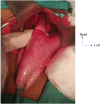Perioperative outcomes of the surgical management of achalasia in two tertiary Cameroonian hospitals: a cohort study
- PMID: 38519934
- PMCID: PMC10958949
- DOI: 10.1186/s12876-024-03191-1
Perioperative outcomes of the surgical management of achalasia in two tertiary Cameroonian hospitals: a cohort study
Abstract
Introduction: Achalasia is a rare esophageal disease with potentially lethal complications. Knowledge of the outcomes of the different surgical treatment modalities for achalasia by Heller's cardiomyotomy (HCM) helps to choose the safest and most effective option. However, data on the management of achalsia using a Heller myotomy is limited in Africa. Thus, our aim was to determine the perioperative morbidity, mortality and short-term functional outcomes of HCM in Cameroon.
Methodology: We conducted a cohort study throughout a 10-year chart review of patients who underwent HCM for achalasia and were followed up postoperatively for at least three months at two tertiary health centers in Cameroon. We analyzed demographic data, preoperative clinical and imaging data, treatment details, and outcomes at three to twelve months after HCM using the Eckardt score.
Results: We enrolled 29 patients with achalasia having a mean age of 24 ± 16 years and predominantly females (M/F of 1/3.8). The mean symptom duration was 51 ± 20 months. In 80% of cases, the diagnosis was made through a conventional x-ray contrast imaging or "barium swallow test" (93%) and/or an upper gastrointestinal endoscopy (86%). The gold standard diagnostic method via esophageal manometry was unavailable. Preoperatievly, all patients had symptoms suggestive of an active achalasia. HCM was performed via laparotomy in 75% as opposed to 25% laparoscopic HCM procedures. Dor's anterior partial fundoplication was the main anti-reflux procedure performed (59%). Mucosal perforations were the only intraoperative complications in eight patients (2 during laparoscopy vs. 6 during laparotomy; p > 0.5) and were managed successfully by simple sutures. Postoperative complications were non-severe and occurred in 10% of patients all operated via laparotomy. The mean postoperative length of hospital stay was 7 ± 3 days for laparotomy vs. 5 ± 2 days for laparoscopy; p > 0.5. The perioperative mortality rate was nil. Overall, the short-term postoperative functional outcome was rated excellent; average Eckardt score of 1.5 ± 0.5 (vs. preoperative Eckardt Score of 9 ± 1; p < 0.0001).
Conclusion: Achalasia is diagnosed late in this resource-limited setting. HCM yields satisfactory outcomes, especially via laparoscopic management. An improvement in diagnostic esophageal manometry and mini-invasive surgical infrastructure and the required surgical training/skills are needed for optimal achalasia care.
Keywords: Achalasia; Cameroon; Eckardt score; Heller’s cardiomyotomy.
© 2024. The Author(s).
Conflict of interest statement
The authors declare that they have no competing interest.
Figures




References
-
- Stein CM, Gelfand M, Taylor HG. Achalasia in Zimbabwean blacks. S Afr Med J. 1985;67(7):261–2. - PubMed
MeSH terms
LinkOut - more resources
Full Text Sources

